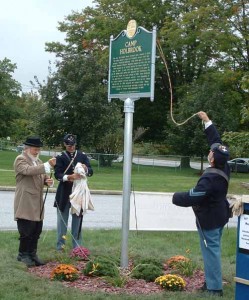 It was on Sept. 16, 1860 that some 1,000 men of the 5th VT Volunteer Infantry Regiment bravely set out on an incredible adventure.
It was on Sept. 16, 1860 that some 1,000 men of the 5th VT Volunteer Infantry Regiment bravely set out on an incredible adventure.
Dressed in their new blue uniforms, most armed with muskets, they marched from their muster site, Camp Holbrook, which was located on the old Horatio Platt Seymour farm along Route 7, just north of the intersection of 105. They made their way down to the Central Railroad Station, where they boarded the train and headed to Washington, D.C.
Several days prior, the Seymour land that now houses the Vermont Federal Credit Union and the West Villa Estates had been speckled with 100 white tents, and the smell of campfire smoke and latrines still lingered in the air.
On Saturday, Sept. 24, 2011 the 18th Vermont Regiment, a small non-profit group that strives to promote Vermont’s Civil War heritage, erected a Camp Holbrook historical highway marker and held the dedication ceremony and military salute thereby giving the 5th VT Volunteer Infantry the recognition it so richly deserves.
During the ceremony Jim Fouts of the 18th VT introduced its president, Bill McKone, who portrayed Vermont Civil War era Gov. Erastus Fairbanks and together the recounted the amazing story of the 5th VT’s involvement in the Civil War.
“They were an enthusiastic but very naive group of young soldiers who did not have much training,” Fouts said.
“These men had no idea what they were in for, the amount of marching they would do and the hardships they would have to live through,” he told the onlookers.
The 5th VT was a three-year regiment comprised of enlisted men from Companies A-J, and K that came from St. Albans, Middlebury, Swanton, Hyde Park, Manchester, Cornwall, Rutland, Brandon, Burlington, Poultney, Tinmouth and Richmond.
Camp Holbrook was named in honor of the newly elected Gov. Frederick Holbrook, of Brattleboro.
On Sept. 16, 1861, the regiment was mustered into service under the command of Colonel Henry A. Smalley, a Burlington native.
By early October four Vermont regiments were at Camp Griffin, and the men of the 5th VT built fortifications and served on guard and picket detail.
The enemy proved much less of a threat to the soldier than the cold, wet conditions and the disease that spread through the encampment.
Fouts said that by mid March measles, mumps, typhoid fever, malaria and dysentery had claimed the lives of about a fifth of the men of the 2nd, 3rd, 4th and 5th Regiments.
In the spring the 5th VT joined the Army of the Potomac at Fortress Monroe where they took part in the Peninsula Campaign.
That June at Savage’s Station the 5th VT suffered its worst blow with more men killed and wounded that any other regiment in any other engagement during the entire war.
“In this battle, with not over 400 muskets, it lost 188 officers and men in 30 minutes of combat,” Fouts explained.
But their story didn’t stop there, they marched on to serve as reserve for the second battle of Bull Run, then on to join the Maryland Campaign action at Crampton’s Gap and Antietam and returned to Virginia for the winter of 1862-63.
In May they took part in the assault on Marye’s Heights, with the Vermont Brigade, then headed west, rejoining the Army of the Potomac at Chancellorsville, for another hard fight at Salem Church.
By June they were involved in the Gettysburg campaign, and then pursued the Confederates into Virginia and up to New York.
That fall they returned to the Army of Potomac for the campaign in northern Virginia, then set up winter camp near Brandy Station.
Fouts said that many of the men of the 5th VT re-enlisted in early December and went home on a veteran’s furlough.
There’s more. Fouts also told how the 5th VT participated as a veteran organization in U.S. Grant’s 1864 Overland Campaign, and was instrumental in the siege of Petersburg.
In July they returned to Washington and with the 6th Corps confronted and drove away Confederate Gen. Jubal Early and his troops.
Fouts said that in Sept. of 1864, original members of the 5th VT that had not re-enlisted were mustered out at Clifton, Va., leaving behind a regiment of 5 officers and 300 men.
“This fragment of a regiment participated in Sheridan’s campaign in the Shenandoah Valley, fighting at Winchester, Fisher’s Hill and Cedar Creek before returning to the trenches around Petersburg,” said Fouts.
He added that the 5th VT was the “spearhead” of the Vermont Brigade’s final assault on Petersburg on April 2, 1865.
“They were the first regiment to reach the enemy’s works and to plant their colors on the Confederate parapet,” said Fouts.
“For his bravery that day, Color Sergeant, Jackson Sargent received the Medal of Honor,” Fouts added.
“And I’m proud to say that his great grandson, John Sargent, is a member of the 18th VT Regiment,” said Fouts.
Next, the 5th VT joined in the pursuit and capture of the Army of Northern Virginia, and following General Lee’s surrender it marched south to Danville, where they assisted Gen. Sherman by preventing the escape of Gen. Johnston’s Confederate Army.
When the war was finally over the 5th VT marched back to Washington.
“Only 24 officers and 288 men out of the total enrollment of 1,618 remained in the ranks when the veterans and recruits of the 5th VT Volunteer Regiment were mustered out of service on June 29, 1865,” Fouts said.
During the 5th VT’s four years of service 201 men were killed or died of their wounds, 112 died from disease, 21 died from the effects of imprisonment, and four died by accident.
“The 5th VT is listed as one of the 45 Infantry Regiments, out of all the regiments of the Union armies that lost over 200 men, killed or mortally wounded in the battle during the War of the Rebellion,” Fouts said.
“The fortunes of this regiment were many months of hard fighting and miles of weary marching, but at the end the attainment of lasting renown,” Fouts said.
Fouts encouraged all to take off their hats for three “Hip! Hip! Housa!” cheers for the 5th VT.
Bill McKone (as Gov. Fairbanks) watched as Fouts, joined by Lt. Mike Frisbee and Charlie Martin of the Champlain Valley Historical Reenactors fired their muskets to salute the brave men of the 5th VT.
Fouts, who is the former president of the 18th VT Regiment, thanked: Bill McKone, current president of the 18th VT, for his assistance with the project; Lt. Mike Frisbee and Charlie Martin, Champlain Valley Historical Reenactors; John Dumville, Historic Sites Operations Chief, who is also a trustee/member of the 18th VT Regiment for procurement of the roadside marker; Tom Crapo, senior vice president of Operations, Vermont Federal Credit Union for his enthusiastic support for the project, and the crew from G and G Lawn Care Service for installing the marker and landscaping the site.
By ANN HAWKSBY
St. Albans Messenger Correspondent



